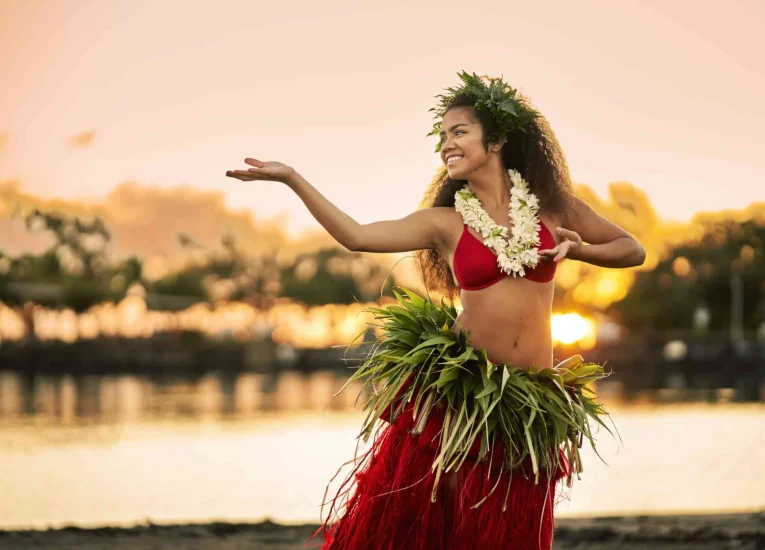Unveiling the Magic of Tahitian Dance
French Polynesia, a paradise of turquoise waters, swaying palm trees, and vibrant culture, beckons travelers with its captivating beauty. But beyond the postcard-perfect scenery lies a deeper layer of tradition – the mesmerizing art of Tahitian dance. This dynamic performance form, steeped in history and rich with symbolism, is more than just entertainment; it’s a rhythmic journey through Polynesian mythology, a celebration of life, and a window into the soul of the islands.
Roots of Rhythm: A Legacy Passed Down Through Generations
The origins of Tahitian dance stretch back centuries, with roots deeply embedded in Polynesian mythology. Legend tells of the goddess Hi’i-varea, who descended from the heavens to teach the people the art of dance. Early forms of the dance were used for religious ceremonies, storytelling, and celebrating victories in war.
Over time, the dance evolved, incorporating influences from European missionaries and sailors. Missionaries initially tried to suppress the traditional dance due to its perceived sensuality. However, the Tahitian people cleverly adapted their dances, incorporating elements like longer skirts and slower movements while preserving the core essence of the form.
Today, Tahitian dance holds a cherished place in Polynesian culture. It’s passed down through generations, with families teaching their children the intricate steps and rhythmic beats. From village festivals to prestigious competitions, Tahitian dance continues to be a vibrant expression of cultural pride and identity.
A Story Told Through Movement: Unveiling the Dance Styles
Tahitian dance, also known as « Ori Tahiti, » is a captivating blend of powerful movement, rhythmic drumming, and captivating storytelling. Two main styles dominate the dance landscape:
- Otea: This dynamic and energetic style traditionally performed by men, features vigorous footwork, powerful chest slaps, and dramatic gestures. The Otea tells stories of war, bravery, and hunting prowess. The dancers, often bare-chested and adorned with elaborate headpieces and belts, convey strength and agility through their movements.
- Mehe: This graceful and sensual style, primarily performed by women, showcases elegance and beauty. The dancers, adorned with vibrant flower crowns and colorful pareos, move their hips and hands in a fluid, mesmerizing rhythm. The Mehe tells stories of love, creation, and everyday life, captivating the audience with its subtle emotions and hypnotic movements.
The Enchantment of Costumes: Beyond the Dance Steps
The visual splendor of Tahitian dance is as captivating as the movements themselves. The costumes play a crucial role in conveying the story and highlighting the dancers’ skill and grace.
- Men: Traditional attire for Otea dancers can include colorful loincloths made from tapa cloth (bark cloth). They might wear elaborate feather headdresses or headbands adorned with shells and flowers. Some dancers wear ankle bracelets made of boar tusks or nacre shells, which add an audible rhythmic element as they move.
- Women: Mehe dancers wear brightly colored pareos (wraparounds) made from tapa cloth or cotton. The vibrant colours like red, yellow, and orange, symbolize joy and celebration. They adorn themselves with flower crowns (hei) made from fragrant plumeria or tiare flowers. These crowns not only add a touch of beauty but also infuse the performance with the intoxicating scent of Polynesia.
The Pulse of the Performance: The Rhythm of the Toere
The heartbeat of Tahitian dance is the toere, a traditional drum carved from a hollowed tree trunk. Skilled drummers, known as « toere pu, » use a variety of sticks and their hands to create intricate rhythmic patterns. These rhythms not only guide the dancers’ movements but also narrate the story being told through the dance.
The toere is often accompanied by the powerful chanting of the « pupu himene, » a chorus that provides a vocal counterpoint to the drumming. The chanting adds another layer of storytelling and emotional depth to the performance.
Witnessing the Magic: Where to Experience Tahitian Dance
Tahitian dance performances are accessible to visitors throughout French Polynesia. Many hotels and cultural centers host regular dance evenings, allowing tourists a glimpse into this vibrant tradition.
For a more immersive experience, consider attending a Heiva festival. Held annually in July, these vibrant celebrations showcase the best of Tahitian culture, including dance competitions, craft demonstrations, and traditional food stalls.
Beyond Entertainment: A Cultural Journey for All
A Tahitian dance performance is more than just an entertaining spectacle; it’s a journey into the heart and soul of Polynesian culture. Witnessing the dancers’ grace, the rhythmic energy of the toere, and the vibrant costumes is a sensory feast that leaves a lasting impression.


0 Comment